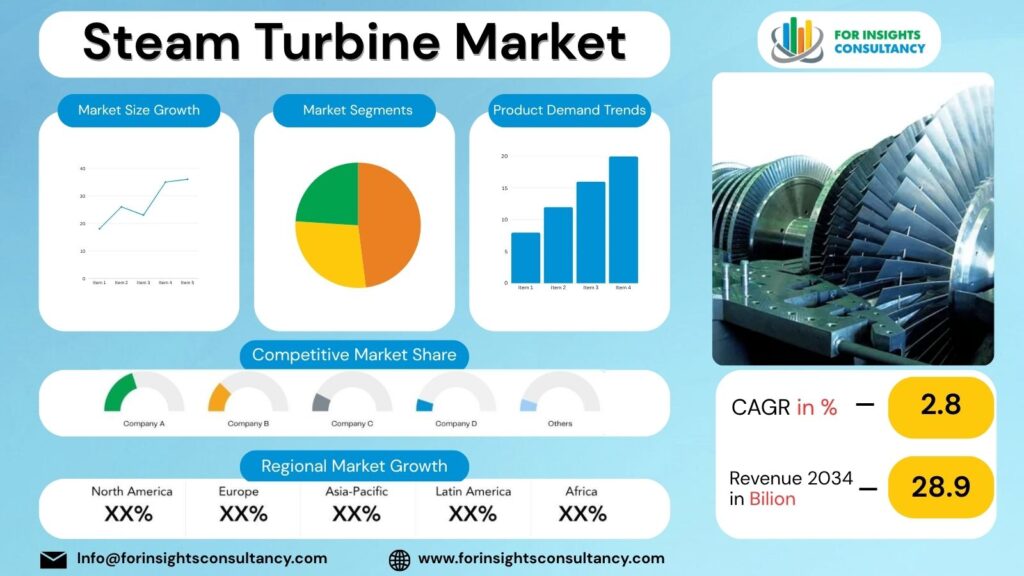
Steam Turbine Market Size, Trends Analysis Research Report By Type (Impulse, Reaction), by Capacity (Up to 150 MW, 151–300 MW, Above 300 MW), by End User, and By Region Global Market Analysis And Forecast, 2025-2034
Nov-2025 Formats | PDF | Category: Energy & Power | Delivery: 24 to 72 Hours
Global revenue from the Steam Turbine market is projected at US$ 24.8 Billion in 2025 and has been blunt to existing at a CAGR of 2.8% to extent US$ 28.9 Billion by the end of 2034.
Steam Turbine Market Research Summary
The steam turbine market is undergoing a major expansion as a result of the rising global demand for clean and efficient power generation solutions. A detailed overview of this nature is aimed at providing a fresh insight into a market that looks very different today from what is was in the past and also gives a glimpse of the future of the industry.
The steam turbine market will increase its size moderately and the upward trend will continue through the next years. The main reason of this growth will be a transition to energy sources and technologies less harmful to the environment. The scenario of market demand expansion is in accordance with the effects of Industrialization and Urbanization, as well as Governments’ commitment to reducing CO2 emissions.
Top-ranking companies of the steam turbine market scenario are General Electric, Siemens, Mitsubishi Hitachi Power Systems, and Toshiba Corporation. They are launching new products on the market and continuing to invest in R&D as a way for them to maintain their leading position in the competitive space.
By far the most talked about technological improvement of steam turbines is the transition and innovations in the supercritical and ultra-supercritical technology. The result of this improvement is higher efficiency and lower emissions. Thus, these are the main drivers of the market growth in the next years.
Technological advancement and eco-friendliness, in fact, being the most crucial factors, define the market of steam turbines to be expanded to a great extent in the near future. It is very important for the people who are participating in the industry to be ready and creative in the global energy market whose demands are continuously changing.
Market Insights
In the 2024 market analysis for the Steam Turbine Market, the largest regional revenue share is projected to be in the Asia-Pacific region, with a significant growth forecast.
The percentage of the U.S. population residing in urban areas is expected to be around 80%, indicating a high level of urbanization.
In terms of market segments, the largest revenue share is expected to come from the power generation segment, followed by the industrial sector.
Overall, the Steam Turbine Market is poised for substantial growth in 2024, driven by increasing demand for electricity and industrial applications worldwide.
Market Dynamics
Trends
Sustainability Focus: There has been a growing demand for more efficient and environmentally friendly steam turbine technologies in order to lower the carbon footprint of the power generation sector.
Digital Transformation: The use of cutting-edge digital solutions such as IIoT and predictive maintenance to operational efficiency and downtime minimization is highly welcomed.
Increased Investments: There is a trend of increasing investments in the refurbishment of old steam turbine units and in the installation of new ones to cater to the rising energy demand of various industries.
Market Expansion: The rapidly growing economies of the Asia-Pacific region and Africa are the two major areas where steam turbine manufacturers can find profitable opportunities for increasing their global presence.
Shift towards Combined Heat and Power (CHP): The adoption of CHP systems mainly utilizing steam turbines for the joint production of electricity and heat, thus leading to an increase in the market, is a widely spread idea.
Growth Drivers
One of the major factors contributing to the increased use of steam turbines is the demand for electricity generation from renewable energy sources.
The huge focus on efficient and environmentally friendly power generation technology has also been a major driver of the market.
The rise in industrialization and urbanization that is pushing the demand for energy is also a significant factor contributing to the increased use of steam turbines.
Some factors behind the rising consumption of steam turbines are government initiatives promoting the use of steam turbines for power generation.
Improvements in technology leading to better performance and higher efficiency of steam turbines have also been a significant factor in the growing market of steam turbines.
The growth of the manufacturing sector has been a major factor contributing to the increased use of steam turbines as well as the need for a reliable supply of electricity.
One of the major steps taken by the authorities to meet the growing energy needs is to make investments in the upgrading of the aging power infrastructure.
Restraints
Environmental Regulations: A major concern regarding carbon emissions and a shift towards renewable energy sources might result in stricter environmental regulations, thereby limiting the growth of steam turbines.
Competition from Alternative Technologies: The increased use of solar, wind, and geothermal energy technologies as cleaner and more environmentally friendly energy sources might become a reason of decline in the demand for steam turbines in the market.
High Initial Investment Costs: One of these potential buyers or investors could be a person who is discouraged by a 2024-2025 forecast period, where there is a requirement for a significant upfront investment, for example, in steam turbine installations.
Limited Efficiency Improvements: The maturity level of steam turbine technology may be a factor that limits the further enhancement of its efficiency, thus possibly impeding the growth of the market in the near future.
Opportunities
The expanding need for clean energy is the major factor behind the increased usage of steam turbines.
The increasing expenditures in the energy sector are likely to have a positive impact on the industry.
Improvement in technologies are the main reasons to the increased performance and efficiency of steam turbines.
The growth of industrial infrastructure in less developed areas is opening up new possibilities for the companies operating in the market.
The increasing emphasis on cutting down carbon emissions is the main reason for the growing use of steam turbines in power generation.
Challenges
The rise of competitors primarily solar and wind energy has put up a tough struggle for traditional energy sources .
Volatile prices of raw materials affect the costs of production.
Tight environmental rules are resulting in high costs for meeting the regulations.
The increasing thirst for energy-saving appliances that leads to continuous innovations.
The ups and downs of the political situations and the uncertainty in trade that causes the market to be unstable.
The decline in worldwide industrial operations that results in fewer new installations.
The shortage of skilled workers and lack of technical knowledge in the steam turbine sector.
Steam Turbine Market Top Companies Covered In This Report:
Evaluate The Strategic Positioning And Innovation Pipelines Of Leading Market Companies-From Multinational Enterprises To Disruptive Regional Firms. Understand How Key Players Are Innovating, Expanding, And Capturing Value, And Use Competitive Benchmarks To Plan Your Next Move.
- Fuji Electric Co., Ltd.
- General Electric
- Kawasaki Heavy Industries, Ltd.
- MAN Energy Solutions
- Ansaldo Energia S.p.A
- Bharat Heavy Electricals Limited,
- Doosan Škoda Power
- Elliot Group
- Mitsubishi Power Ltd.
- Siemens Energy
- Toshiba Corporation
- Trillium Flow Technologies
Steam Turbine Market Company News 2024 and 2025
Fuji Electric Co., Ltd.
Fuji Electric Co., Ltd. unveiled a new series of high-efficiency steam turbines aimed at improving output and reducing carbon emissions in 2024.
General Electric
General Electric expanded its turbine modernization services with advanced digital monitoring systems for better performance analytics.
Kawasaki Heavy Industries
Kawasaki Heavy Industries, Ltd. launched compact turbine models designed for industrial and waste-to-energy applications.
Ansaldo Energia S.p.A
Ansaldo Energia S.p.A. secured multiple global contracts for large-scale power plant turbine installations in 2025.
Key Segments
Segmentation By Type
- Impulse
- Reaction
Segmentation By Capacity
- Up to 150 MW
- 151–300 MW
- Above 300 MW
Segmentation By End User
- Power Generation
- Industrial
- Marine
Segmentation by Design
- Condensing
- Non-condensing
Global Geographic Coverage:
The Report Provides In-Depth Qualitative And Quantitative Data On The Steam Turbine Market For All Of The Regions And Countries Listed Below:
North America
As to the North American Steam Turbine market, the anticipated GDP Growth is expected to be around 2.5% with an inflation rate of 2.0%. A local, non-replicable factor that is positively influencing the market in the region is a clean energy policy supported by the government and aimed at cutting down carbon emissions by encouraging the use of clean energy sources. As a result of this, the main channel through which steam turbines are sold is via industrial suppliers, whereas the quickest expanding channel is direct-to-consumer online sales.
Consumers in North America are giving priority to sustainability and ethical sourcing when buying steam turbines. But, in quite a few emerging markets in the region, prices and status are still the most important factors of consumer preferences. In general, the steam turbine market in North America is set to grow gradually as a result of the dominant factors of the sector such as the strong focus on energy-saving measures and the technological progress.
Europe
The European Steam Turbine Market is expected to grow gradually over the next years, which is supported by a GDP growth of 2% and an inflation rate of 1.5% that are both expected. One of the local factors in Germany that pushes up the demand for steam turbines is the subsidy by the government which encourages renewable energy initiatives. The main channel of distribution for steam turbines in Europe is through industrial suppliers, while online sales constitute the fastest-growing channel due to digitalization trends.
Consumers in Europe are becoming more and more conscious of the environmental impact and the ethical aspect of the production when buying steam turbines, thus, these factors turning into necessities for numerous ones. In the emerging markets in the Eastern part of Europe, price and status are still the main factors influencing consumer preferences, with particular emphasis on affordability and product prestige. To sum up, the European steam turbine market is adjusting to the new demands of consumers and the requirements of the regulations, with the increasing focus on sustainability and innovation.
Asia Pacific
There is a prediction that the market for steam turbines in Europe will continue to be profitable over several years. This will be possible due to a GDP growth of around 2% and the inflation rate remaining at approximately 1.5%. In Germany an inducement from the government to carry out renewable energy projects is the main reason that locally the demand for steam turbines is increasing. Europe is mainly supplied with steam turbines through industrial suppliers; however, the online sales channel is the quickest-growing one due to the digitalization trend.
European consumers have become more conscious about the environment and the ethical sourcing of steam turbines, which are now considered the most important criteria for purchases by many of them. In the developing markets of Eastern Europe, the price and the status of the product still have the most influence on consumer behavior where affordability and product prestige are emphasized. The European market for steam turbines is transitioning to align with changing consumer and regulatory requirements, with a growing focus on sustainability and innovation.
Middle East and Africa
The market for steam turbines in Europe is expected to remain stable over the next several years with some increase. This expansion is largely attributed to a forecasted GDP growth of 2% and an inflation rate of 1.5%. In Germany, the subsidy offered by the government to support renewable energy projects is the main factor locally that is driving the demand for steam turbines. The main channel for the distribution of steam turbines in Europe is through industrial suppliers, whereas online sales are the fastest-growing channel due to digitalization trends.
Consumers in Europe are becoming more and more concerned about the environment and the ethical sourcing of products when buying steam turbines, thus these aspects have become essential for most of them. In the emerging markets of Eastern Europe, price and status are still the main factors influencing consumer choices, whereby emphasis is laid on affordability and product prestige. The European steam turbine market, in general, is transitioning to be able to accommodate the changing consumer demands and regulatory requirements, with a rising commitment to sustainability and innovation.
Frequently Asking Questions
What is the Steam Turbine market size and growth forecast?
Steam Turbine Market is predicted to grow from USD 24.8 Billion in 2025 to approximately USD 28.9 Billion by 2034. the industry is estimated to expand at a CAGR of 2.8%.
Who are the key players in the Steam Turbine market?
The Steam Turbine Market Includes Major Companies Fuji Electric Co., Ltd., General Electric, Kawasaki Heavy Industries, Ltd., MAN Energy Solutions, Ansaldo Energia S.p.A, Bharat Heavy Electricals Limited,, Doosan Škoda Power, Elliot Group, Mitsubishi Power Ltd., Siemens Energy, Toshiba Corporation, Trillium Flow Technologies, Others.
What are the current and future trends for Steam Turbine market?
Current trend: Increasing demand for energy efficiency and sustainable power generation driving growth in the Steam Turbine market. Future trend: Advancements in technology leading to improved efficiency and performance of Steam Turbines in the market.
What are the challenges facing the Steam Turbine market?
Challenges facing the Steam Turbine market include increasing competition from alternative energy sources like solar and wind power.
Which regions dominate the Steam Turbine market?
Asia-Pacific dominates the Steam Turbine market, driven by rapid industrialization, rising energy demand, and expanding thermal power generation in countries like China and India.
Report Features
This report gives the most complete information. The report on Steam Turbine Market format has been designed so that it can provide the best value to the business. It offers crucial insights into the market’s dynamic and will aid in strategic decision-making for current players as well as those looking to join the market.
What Deliverables Will You Get in this Report?
Key questions this report answers | Relevant contents in the report |
How big is the sales opportunity? | In-depth analysis of the Global Steam Turbine Market |
How lucrative is the future? | Market forecast and trend data and emerging trends |
Which regions offer the best sales opportunities? | Global, regional and country level historical data and forecasts |
Which are the most attractive Steam Turbine market Key segments? | Market segment analysis and |
Which are the top Key players and Their Steam Turbine market positioning? | Competitive landscape analysis, Market share analysis |
How complex is the business environment? | Porter’s five forces analysis, PEST analysis, Life cycle analysis |
What are the factors affecting the Steam Turbine market? | Drivers & Restraints |
Will I get the information on my | Customized Report as per your Business Needs Our analysts will work directly with you and understand your needs Get data on specified regions or segments, competitor and Vendors Data will be formatted and presented as per your requirements Any Requirement Contact Us: Https://Www.Forinsightsconsultancy.Com/Contact-Us |
Table of Contents
For TOC Contact us: https://forinsightsconsultancy.com/contact-us/







